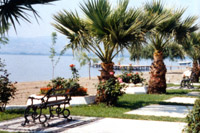İznik
 İznik, with its thousand of years cultural heritage, occupied an important place in history. Having been the capital of four empires, it is one of the remarkable settlement places.
İznik, with its thousand of years cultural heritage, occupied an important place in history. Having been the capital of four empires, it is one of the remarkable settlement places.
History
There are traces of a civilisation dates back to 2500 BC in Karadin, Çiçekli, Yüğücek and Çakırca Mounds near İznik. The settlement before the immigrations of Trak Tribes in the 7th century BC, took the name of Helikare. The word of ‘Khryseapolis’ (Golden City) was printed on the coins having been minted in the city.
Having been renovated by Antigonos, General of Macedonia Emperor Alexander the Great in 316 BC, the city took the name of Antigoneia. After the death of Alexander the Great, the city was handed over to General Lysimakhos who won the battle against Antigonos and named the city as Nicaea, which was also the name of his wife. In 293 BC, it became a part of Bithynia Kingdom. During this period, the city was decorated with important architectural structures. Nicaea, having been the capital city of Bithynia Kingdom for a period, later on continued its presence as an important settlement area of the Romans.
Nicaea got acquainted with Christianity by the efforts of Petrus, one of the disciples of Bithynia. During the reign of Emperor Constantine the 1st, the prohibitions on Christianity were removed. In the early summer of 325 AD, Nicaea was the scene of an important meeting of 1st Consul in Senatus Palace. A text comprising of 20 articles, known as Nicaea Laws, and Christianity Feast Days were approved after this consul.
In 787 AD, 7th Consul gathered in Hagia Sophia Church in İznik. The prohibitions on paintings and statues were removed under the leadership of Empress Irene.
İznik has also been the capital city of the Seljuks and Byzantines through history.
After having been captured by the Ottoman Army in 1331, İznik became a more active city and a centre of art, culture and trade. Many famous people lectured in Orhan Ghazi Madrasah during this period. The first Mosque, Madrasa and İmaret (Soup Kitchen) of Ottoman Period were built in İznik.
İznik became an art centre during the 14th and 15th centuries, and world wide famous tiles and ceramics were produced here. Its city texture, with its grid-planned city settlement from Hellenistic Age and monumental structures from the Romans, Byzantines and Ottomans, has still been preserving in İznik.
Climate
İznik has a temperate climate with wet winters. In summers, it is sufficiently rainy.